
Efficiently run food supply chains can positively impact communities and lives across the globe. Real-time tracking supports sustainability, prevents food waste, and ensures compliance with environmental, social and governance (ESG) standards. Communication throughout the supply chain can help producers earn fair compensation for their efforts. Ultimately, being able to track food from source to stomach improves the health and wellness of communities everywhere.
Conversely, companies taking a traditional approach to food supply chain management face challenges to efficiency, security and transparency. The consequences can be dire, from food waste to death by contamination.
There is a solution that can not only improve food supply chain management, but also increase the quality of life for everyone around the globe. Blockchain technology can provide much-needed transparency, traceability and privacy, as well as co-ordination across disparate parties, enabling greater food access and quality improvements across the global supply chain.
Food supply chain challenges
One company that has felt the challenges of today’s approach to supply chain management is Silal. Despite being an established player in the agritech space known for its commitment to quality and freshness, Silal Fresh, the fresh produce division of Silal, had trouble tracing its products across their supply chain. Gaps in traceability may pose challenges to food safety in terms of identifying where issues regarding food quality originated.
Traceability issues aren’t the only challenges food suppliers and retailers face today. Other hurdles to better food quality and delivery include:
Lack of communication: Even though goods pass from touchpoint to touchpoint along a supply chain, there’s often a lack of communication between them. In fact, 45% of supply chain leaders only have visibility to their first-tier suppliers or no visibility at all, and only 7% have multi-tier transparency. This results in a lack of supply-chain resiliency, making it hard for retailers to anticipate disruptions simply because they don’t know they’re coming. It also results in an inability to efficiently track and trace items in real time, as well as difficulty in proving the provenance of goods. A lack of tracking results in a lack of quality assurance, as well as the inability for thorough compliance reporting. Finally, a lack of communication can result in a lack of access to financing for upstream suppliers who remain cut off from downstream financiers.
Lack of privacy: Across today’s supply chain, there’s a lack of symmetry when it comes to information-sharing. Upstream suppliers will be more likely to withhold information about their operations, pricing and sourcing to keep a competitive advantage. However, downstream retailers want to know this information about their products and goods. Unfortunately, legacy data management tools often lack the ability for such granular control over information-sharing.
Lack of security: Another supply chain challenge is keeping the system secure, especially when centralized servers are vulnerable to attacks that can easily impact the entire supply chain. Third-party vendor risk is an increasing challenge today, with at least 56% of cybersecurity incidents happening in the supply chain.
